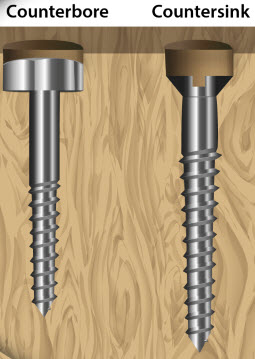Counter Sink vs Counterbore 
Countersink
 Countersinking involves creating a cone-shaped hole in a surface to allow a flat head fastener to sit flush when installed. This technique ensures that the top of the fastener is level with or slightly below the surface, preventing any snagging or potential damage. Without countersinking, the fastener’s head might protrude, leading to possible injury or equipment malfunction due to the uneven surface.
Countersinking involves creating a cone-shaped hole in a surface to allow a flat head fastener to sit flush when installed. This technique ensures that the top of the fastener is level with or slightly below the surface, preventing any snagging or potential damage. Without countersinking, the fastener’s head might protrude, leading to possible injury or equipment malfunction due to the uneven surface.
When working with wood, not countersinking and forcing a screw into the surface can lead to several issues. Besides the unsightly appearance, this practice compromises the stability of the wood. Forcing the screw without countersinking can cause the wood to crack and split, as the fibers become damaged and dented under pressure. This damage not only weakens the wood but also diminishes the overall integrity and longevity of the construction.
Countersinking offers the additional benefit of ensuring all screws are installed at a consistent depth. This uniformity is crucial for both the structural soundness and the aesthetic finish of the project. By allowing screws to be embedded smoothly and evenly, countersinking helps maintain the strength of the material and enhances the professional appearance of the final product.
Counterbore
Counterboring is a technique similar to countersinking, but with a few key differences. Instead of creating a cone-shaped hole, counterboring produces a larger hole with a flat bottom. This allows a screw or bolt with a flat underside to sit flush with the surface, providing a stable and secure hold. The flat bottom of the counterbore ensures that the fastener is seated firmly, which enhances the overall structural integrity of the assembly.
A significant advantage of counterboring is that it accommodates fasteners with a flat underside, such as hex bolts and socket head screws. The larger diameter of the counterbore hole is often designed to be wide enough to fit a socket or wrench, making it easier to tighten or loosen the fastener. This accessibility is particularly useful in applications where a flush surface is essential, and the fastener needs to be securely tightened without protruding.
Counterboring is commonly used in various industries, including automotive, aerospace, and construction, where precise and strong fastening is required. The technique not only ensures a clean and professional appearance by hiding the fastener heads but also enhances the functionality and safety of the assembled parts. By providing a flush, stable fit, counterboring helps maintain the integrity of the material and the reliability of the entire construction.
Are you looking for fasteners?
Submit an RFQ now!
